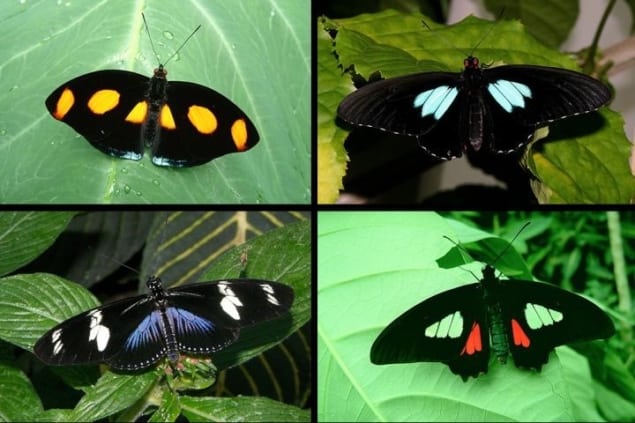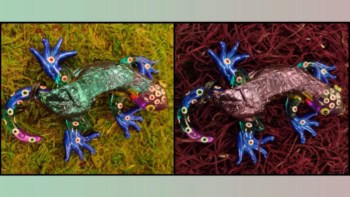
Many male butterflies have exceptionally black wings with optical properties that have long-puzzled scientists. Now researchers in the US found that the wings of at least 10 species have nanoscale structures that increase light absorption and scattering that create the “ultra-black” appearance. These structures may have evolved to enhance the contrast of colour patches used in courtship displays, according to the researchers. Understanding why the wings are so dark could lead to the development of ultra-black synthetic materials.
Butterfly wings are made of scales that usually consist of two chitin layers. One layer is a smooth, flat plate. The other layer has ridges that are connected by cross ribs to form a honeycomb-like structure. The two layers are connected by pillars known as trabeculae.
It has been suggested that the size of the nanoscale holes in the honeycomb-like structure on the upper scales could be responsible for the extreme light-absorbing properties of some butterflies. But when Alex Davis at Duke University and colleagues examined the scales of 10 butterfly species that are exceptionally black, they found that that was not the case.
Extremely low directional reflectance
When the researchers shone light on specimens from museum and university collections, they found that the black scales had an extremely low directional reflectance. With the light source perpendicular to a wing’s surface, the ultra-black butterflies only reflected between 0.06 and 0.4% of light, they report in Nature Communications. In contrast, “control” butterflies that are brown or less black, had reflectance values of 1–3%.
Scanning electron microscopy on both the ultra-black and control butterflies found, however, that there was considerable variation in the shape and size of the holes in the upper wing scales – with them ranging from honeycombs and rectangles to a V-shaped pattern. The ultra-black specimens covered four different subfamilies of butterflies and there was little similarity between the hole structures. This led the researchers to conclude that hole shape or size is not linked to ultra-blackness.
Instead, Davis and colleagues found that other structures were very similar across the ultra-black specimens. The parallel ridges and trabeculae on their wing scales were much deeper and thicker than in the control butterflies, which had larger gaps between the ridges and either no or significantly reduced trabeculae.
Computer models
Next the team created computer models of different wing scales. Simulations of scales without either the ridged surface or interior pillars reflected up to 16 times more light, while those lacking both were up to 28 times more reflective.
Davis told Physics World that expanded trabeculae and ridges, the ultra-black butterflies have more surface area for absorbing and scattering light. This combined with the light absorbing pigment melanin, which is embedded in the structure, produces the low reflectance. Light enters the scales and bounces around, but very little bounces back.
This structure is so good at absorbing light that the ultra-black scales still appear black when coated with gold for scanning electron microscopy, the researchers report.
Brightly coloured areas
Ultra-black wing patches in butterflies often border brightly coloured areas. The researchers believe that the black patches have evolved to make those colours appear brighter during courtship. “Given that the males are much blacker than the females in most of these species, we suspect ultra-black scales have evolved to increase the contrast of signals used in mating,” Davies explains. “These butterflies tend to court one another in sunny areas where a typical black scale may look washed out.” Davies thinks there are probably many other ultra-black butterflies using the same structures.

Artificial optical nanostructure outperforms butterfly wings
Silvia Vignolini at the University of Cambridge, UK, who was not involved in the work, thinks there could be a more functional benefit to the enhanced light absorption. “They need to warm up the wings in order to fly,” she explains.
Vignolini adds that the study is interesting because it compares different butterfly species and families and shows how scale morphology can decrease reflection. She cautions, however, that while she sees no reason to doubt the results, the paper lacks detail on how the authors measured reflectance, and what they measured.
It is also not safe to assume that a single, ultrathin (2.5 μm) scale from one of these butterflies would show the same levels of reflectance, Vignolini says, as the researchers studied whole wings. “The wing is composed of more than one scale, and the scales are superimposed on top of each other,” she says. Adding that this means that “you have more scattering, because you have space between each scale”.



